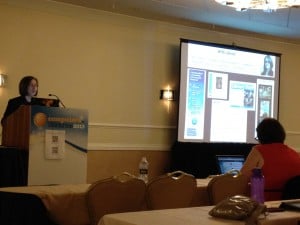The sessions this afternoon include:
Common Core Assignment–“Meet the Candidates” Karen Kliegman
Connected Life and the Library–Diane Cordell
Common Core — Meet the Candidates
Library “buzzwords” fill the common core requirements and standards:
“collaboration” “skills for formal presentations” “integrate information from variety of sources” “use media and visual displays,” etc.
Common Core is like a special “backstage” pass for librarians as teachers struggle to meet the standards–“they validate our importance in the school culture.” Karen Kliegman
Jaeger litmus test:(March/April Library Media Connections?)
- Are you asking students to draw conclusions or just research report?
- Are they answerable with Google search?
- Are they merely a dialog of found facts?
- Have you embedded thought provoking questions
- Are students just repackaging information?
- Do their hypotheses represent their own conclusions or position of someone else?
Project-based learning; project done at schools across country now.
Essential Question–Why do people vote?
Quoting Chris Lehmann-We need to stop saying that school is preparing students for the real world. School should be the real world.
Students studied over the course of the year, how presidents were elected, studied policy questions and had a checksheet, studied political rhetoric with slideshows that Kliegman created, watched campaign ads which they then discussed for advertising technique, and then lastly, students created their own photostory commercial for their candidates–examples on the website. Students held a mock election at the end of unit(despite Hurricane Sandy!)
Pew Internet–Who Uses Social Networking Sites
even 38% of 68 and older connect on social networking
18-29 92% participate in social networking
Local public library has plexiglass cube where students can sign up and curate their own collections. Why can’t communities curate things on your school or public library site?

Using social networking on exemplary library websites:
Dorman High School Media Center (Cathy Jo Nelson) — flickr set of book art
Van Meter Library Voice (Shannon Miller) — using symbaloo, flickr, Twitter, Facebook for library, etc.
Duncanville High School Library– Facebook page, Pinterest board for book club, and “if you liked this book…” lists Pinterest as reader recommendation sites, curation of reading information
QR Codes–
Jennifer LaGarde and Gwyneth Jones have excellent materials on using QR codes for libraries.
QR codes can be used at stations, inside of book covers, for orientation…lots of ideas on Gwyneth’s site.
DIY History sites for students-
Project to transcribe Civil War letters (students can participate)
Facebook hometown pages are a great place for finding and posting historical data, or tagging things that are already there and identifying things.
Mary’s Meals–blog by elementary school student who didn’t like her lunches. Students started the Harry Potter Alliance w/real world projects.
Where on Earth is Kansas project–teacher in Kansas who wanted children to learn about other towns in Kansas. They put it on Facebook–3500 likes–people are responding to them, sending them maps, photographs, etc.
The more variety of social spaces you have for students, the more personalities you can suit.
Book trailers on YouTube — Library Camp for making book trailers. Students had huge number of views–a real voice in the real world.
Internet kick starting a teen poetry revolution–kids who are reluctant to share in person might share it on
Movellas and
Wattpad.
We should look at what public libraries are doing–like the Chicago Public Library’s YOUMedia Labs: digital library space for teens can be a model for schools.
Flickr can be a real source of connection online for students who are photographers. Even commercial sites can be models for what we can do on our sites (Coldwater Creek even has a comments section!)
Audobon’s Great Backyard Bird Count–anyone can participate and share the birds that they see online.
Using Twitter better–
#tlchat for librarians (Texas is now starting #TXLchat)
Like the #CIL campfire, social networks can help us build virtual campfires, but also allow us many divergent ways to connect.
Elementary students can do “paper” social networking (like write tweets on paper–good for practicing brevity, conciseness), do media through their teacher, work with parental permissions, etc. (Question from audience). See wiki for template for paper tweets.
Link to presentation Wiki with the presentation. Also has a list of twittering librarians, twitter accounts of those at CIL, and links to teacher-librarian blogs.
To get parents involved, consider having technology nights for parents when students can teach parents how to use different tools like FB, or Twitter.
